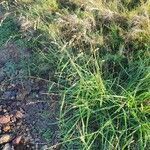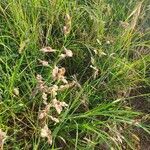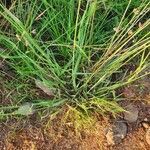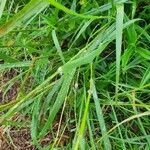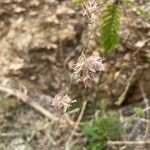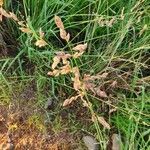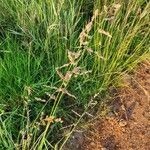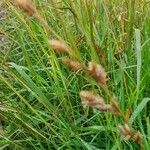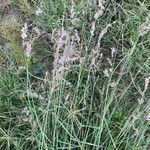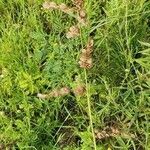Caespitose perennial; culms 20–120 cm. high, erect.. Leaf-blades flat, up to 40 cm. long and 10 mm. wide, firm, glaucous.. Panicle lanceolate to broadly ovate, 10–30 cm. long; primary branches stout, usually with secondary branchlets but sometimes almost raceme-like, the spikelets on short pedicels 1–5 mm. long.. Spikelets 6–28(–47)-flowered, narrowly ovate to suborbicular, 6–16(–23) mm. long, 3–10 mm. wide, strongly flattened, green tinged with brownish purple, disarticulating below the glumes at maturity and falling entire; glumes lanceolate in side view, subequal, 2–4 mm. long; lemma narrowly ovate in side view, 3–4.5 mm. long, strongly keeled, the keel scaberulous, narrowly obtuse; palea 2-nerved, the nerves thickened, cartilaginous, and bearing a hyaline minutely ciliolate wing; anthers 3, 2 mm. long.. Caryopsis ellipsoid, 1–1.5 mm. long.. Fig. 61/9, p. 193.
Spikelets 6–16(23) × 3–10 mm, narrowly ovate to suborbicular, strongly laterally compressed, 6–28(47)-flowered, disarticulating below the glumes and falling entire; glumes subequal, 2–4 mm long, reaching to just beyond the middle of the adjacent lemmas, keeled, lanceolate in profile, glabrous, subacute at the apex; lemmas 3–4.5 mm long, keeled, narrowly ovate in profile, subcoriaceous with conspicuous lateral nerves, diverging from the rhachilla at c. 45° but those in opposite rows imbricate and concealing the rhachilla, green tinged with brownish-purple, scaberulous on the keel, narrowly obtuse at the apex; palea glabrous on the flanks, the keels thickened and cartilaginous, winged throughout, gibbously so below, the wing protruding from the sides of the lemma, the wing margin entire and minutely ciliolate; anthers 3, 1.5–2.5 mm long.
Densely tufted perennial to 1000 mm high; culms often geniculate. Leaf blade to 400 x 3-12 mm. Inflorescence branches and pedicels stout; lowest branches not whorled; axils glabrous. Spikelet 6-16 x 3-10 mm, strongly laterally flattened, sides jagged, disarticulating below glumes at maturity, falling as an entire unit; glumes lanceolate in side view; lemma narrowly ovate in profile, lateral nerves distinct, keel winged and scaberulous; palea keels thickened, broadly winged, entire, minutely ciliolate, projecting laterally from lemma; anthers 3, 1.5-2.5 mm long; caryopsis elliptic.
Perennial; up to 1 m high; densely tufted; often geniculate. Leaf blades up to 400 x 3-12 mm. Flowers: panicle contracted or open; spikelets 6-16 x 3-10 mm; strongly flattened with sides appearing jagged; disarticulating below glumes at maturity and falling as an entire unit; lemmas narrowly ovate in side view; keel winged and scaberulous; palea keels broadly winged; entire; minutely ciliolate; hardly projecting laterally from lemma; anthers 3; 1.5-2.5 mm long.
Perennial, densely tufted (often geniculate), up to 1 m high. Leaf blades up to 400 mm long, 3-12 mm wide. Spikelets 6-16 mm long, 3-10 mm wide, strongly flattened with sides appearing jagged, disarticulating below glumes at maturity and falling as an entire unit; lemma narrowly ovate in profile, keel winged and scaberulous; palea keels broadly winged, entire, minutely ciliolate, hardly projecting laterally frpm lemma; anthers 3, 1.5-2.5 mm long.
Caespitose perennial without rhizomes or stolons; culms up to 120(200) cm tall, erect, often branched above, glabrous at the nodes, eglandular; basal leaf sheaths glabrous, chartaceous to subcoriaceous, terete, eglandular, persistent; ligule a line of hairs; leaf laminas up to 40 cm × 3–12 mm, linear, flat, glabrous, firm and somewhat glaucous, eglandular.
Panicle 10–30 cm long, lanceolate to broadly ovate, the spikelets evenly distributed or somewhat fascicled on stout pedicels 1–5 mm long, the primary branches stout, secondarily branched or sometimes raceme-like, not in whorls, terminating in a fertile spikelet, glabrous in the axils, eglandular.
A grass that keeps growing from year to year. It forms tufts and grows 100 cm tall. The leaves are 40 cm long by 3-12 mm wide.
Caryopsis 1–1.5 mm long, elliptic.
